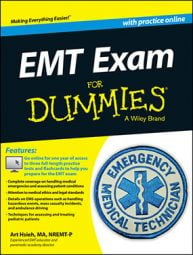The EMT exam includes a cognitive portion and a practical portion. Before you can take the cognitive exam, your training program director must verify your ability to perform the following procedures competently:
Patient assessment/management of a trauma patient
Patient assessment/management of a medical patient
Cardiac arrest management/automated external defibrillator (AED)
Bag-valve-mask ventilation of an apneic patient
Spinal immobilization (for both seated and supine patients)
Long bone fracture immobilization
Joint dislocation immobilization
Traction splinting
Bleeding control/shock management
Upper airway adjuncts and suction
Mouth-to-mouth ventilation with supplemental oxygen
Supplemental oxygen administration to a breathing patient
Your course instructor verifies your skills either throughout the program or at the end of your training; it varies from one program to the next.
You also need to successfully complete a practical (or psychomotor) skills examination. This is usually provided in the form of a final practical exam at the end of your course. The state EMS office determines which exact skills are tested; your instructor will tell you what will be evaluated on the final practical exam.
Find out how your final practical exam will be conducted at the beginning of your course. This way, you’ll know what to pay attention to in your training.
Your results are submitted to the NREMT by your EMT program director after you complete the testing. Once this information is entered into your account and you pay your testing fee, you’ll be cleared to sign up for the cognitive exam.

